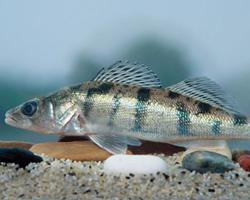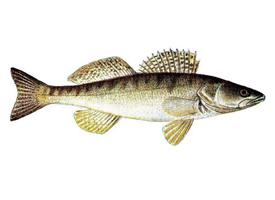
Váhy a míry
| Délka | od 150 do 250 mm |
|---|
Biologická data
| Délka života | 5 r |
|---|
Popis zvířete
The Schraetzer, scientifically known as Gymnocephalus schraetser, is a lesser-known freshwater fish that belongs to the Percidae family, which also includes perches and darters. This species is native to Europe, primarily found in the Danube River basin and its tributaries, extending through several countries from Germany and Austria in the west to the Black Sea regions in the east. The Schraetzer is a species of ecological interest due to its specific habitat preferences and its status in various regions.Physically, the Schraetzer is a slender and elongated fish, typically reaching lengths of up to 25 centimeters, though some specimens may grow slightly larger. Its body is characterized by a somewhat cylindrical shape that tapers towards the tail, enabling swift and agile movement through its aquatic environment. The skin of the Schraetzer is scaleless, which is a distinctive feature among its family members, giving its body a smooth texture. Its coloration is generally a muted blend of gray, green, and brown hues, which provides excellent camouflage against the riverbeds and aquatic vegetation where it prefers to dwell.
One of the most distinguishing features of the Schraetzer is its head, which is relatively small compared to its body, with a sharply pointed snout. This feature, along with its large, upward-looking eyes, suggests a predator well-adapted to ambushing prey from below. Its mouth is equipped with sharp, conical teeth, designed to grasp slippery prey such as small fish and invertebrates that constitute its diet.
The Schraetzer is a demersal species, meaning it lives and feeds primarily on or near the bottom of water bodies. It shows a preference for habitats with slow to moderate flowing waters, such as rivers, streams, and sometimes lakes, particularly those with sandy or muddy bottoms where it can hide and hunt. This fish is known for its solitary and somewhat elusive nature, making it a challenging subject for study and observation.
Reproduction for the Schraetzer occurs in the spring, when water temperatures begin to rise. During this period, males and females come together in specific spawning grounds, which are typically characterized by gravelly or sandy substrates. The female lays eggs that are then fertilized by the male. The eggs are adhesive and attach to the substrate, where they remain until hatching. The early life stages of the Schraetzer are not well-documented, but it is known that juveniles tend to inhabit shallower, more protected areas of water bodies until they mature.
In terms of conservation status, the Schraetzer has faced declines in certain parts of its range, primarily due to habitat loss, pollution, and alterations to river systems such as damming and water abstraction. These factors have led to its listing as a species of concern in some regions, prompting efforts to better understand its ecological needs and to implement measures for its protection.
Despite its relatively obscure status, the Schraetzer plays a vital role in the aquatic ecosystems of Central and Eastern Europe. As a predator, it contributes to the control of prey populations, and its presence indicates healthy, unpolluted water systems. Efforts to conserve the Schraetzer and its habitat not only benefit this species but also support broader biodiversity and water quality objectives in the regions it inhabits.
Podobná zvířata
Nové fotografie zvířat
Top 10 zvířat
- Dolphin gull (Leucophaeus scoresbii)
- Japanese macaque (Macaca fuscata)
- Stone loach (Barbatula barbatula)
- Galápagos tortoise (Geochelone nigra complex)
- Russian tortoise (Testudo horsfieldii)
- Greek tortoise (Testudo graeca)
- Diana monkey (Cercopithecus diana)
- Moustached guenon (Cercopithecus cephus)
- Common flying dragon (Draco volans)
- Galápagos penguin (Spheniscus mendiculus)


